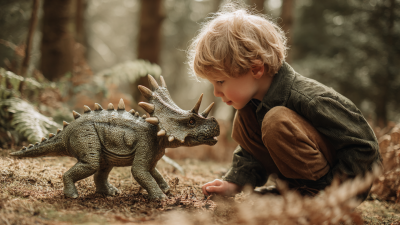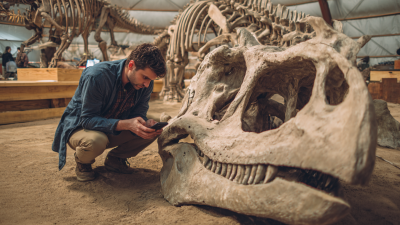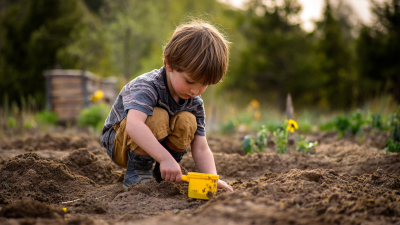How to Create Exciting Learning Experiences with a Dinosaur Fossil Dig Kit
Table of Contents
- Choosing the Right Dinosaur Fossil Dig Kit for Your Needs
- Essential Tools and Safety Tips for a Successful Fossil Dig
- Step-by-Step Guide to Setting Up Your Dinosaur Dig Experience
- Engaging Activities to Enhance Learning and Exploration
- Creative Ways to Incorporate Fossils into STEM Education
- Sharing the Excitement: Displaying and Discussing Your Discoveries
- FAQS
- Conclusion
- Related Posts
In recent years, educational toys have increasingly captured the attention of parents and educators alike, with a significant shift towards hands-on, interactive learning experiences. According to a report by Market Research Future, the global educational toy market is projected to grow at a compound annual growth rate of 10.5% from 2021 to 2026, driven by the rising demand for innovative learning tools. A prime example of this trend is the Dinosaur fossil dig kit, which offers children the unique opportunity to engage in simulated archaeological digs while learning about paleontology and the science behind fossil discovery.

At Jinhua City Dukoo Toys Co., Ltd., we have been dedicated to creating exciting archaeological toys since 2009, specializing in customizing products to meet the diverse needs of our global customers. With our factory expanding from 400 square meters to 8000 square meters over the past 13 years, we continue to innovate and inspire young minds through engaging educational experiences that make learning both fun and memorable.
Choosing the Right Dinosaur Fossil Dig Kit for Your Needs
When choosing the right dinosaur fossil dig kit for your needs, consider what aspects will most engage your child's interest. With a variety of kits available, some focus on realistic excavation experiences that mimic true paleontological digs, while others incorporate educational aspects like fossil identification or the history of dinosaurs. Look for kits that provide comprehensive tools, such as excavation utensils, brushes, and informative guides, as these features can enhance the learning experience and spark a child’s imagination.

Additionally, consider the age appropriateness and skill level of the kit. Younger children might benefit from simpler kits that are easier to handle, while older kids could be more challenged with advanced sets that include multiple fossils and complex digging techniques. Since dinosaurs pique the fascination of young minds, investing in a quality dig kit can serve as an introduction to the exciting world of paleontology, allowing kids to not only play but also learn and discover the science behind their favorite prehistoric creatures.
Essential Tools and Safety Tips for a Successful Fossil Dig
Creating an engaging and safe environment for a dinosaur fossil dig is essential for a successful learning experience. According to a 2021 report by the National Park Service, experiential learning activities—such as fossil digs—can enhance retention rates by up to 75% compared to traditional lecture-based learning. To make the most of a fossil dig, having the right tools is crucial. Essential items include digging tools like small shovels, brushes, and sieves for sifting through soil. Additionally, providing safety gear such as gloves and goggles is vital to ensure that learners remain safe while they unearth their prehistoric treasures.
Safety tips should not be overlooked. A study published in the Journal of Outdoor Education noted that incorporating safety protocols can reduce accident reports in educational digs by 40%. Instruction on handling tools properly and setting clear boundaries for the dig area are important steps to prevent injuries. It’s also beneficial to include hydration and sun protection tips to keep participants comfortable and focused on their exciting discoveries. By prioritizing proper tools and adhering to safety guidelines, educators can cultivate immersive learning experiences that inspire curiosity and a passion for paleontology.
Step-by-Step Guide to Setting Up Your Dinosaur Dig Experience
Creating a captivating dinosaur fossil dig experience is an exciting way to engage learners of all ages. To set up your dinosaur dig, begin by selecting a quality dinosaur fossil dig kit, which typically includes authentic-looking fossils, excavation tools, and a guidebook. According to a study by the National Science Foundation, hands-on learning activities enhance retention by 75%, making this setup invaluable for educational purposes. Prepare an excavation site by utilizing sand or dirt, and strategically bury the fossils to ensure a thorough exploration experience.
Tips: Before the dig begins, set the stage by sharing interesting facts about dinosaurs to pique curiosity. You could mention that nearly 66 million years ago, a mass extinction event wiped out about 75% of the planet’s species, including dinosaurs, according to data from the Smithsonian Institution. This context can enrich the activity and promote deeper learning.
Once digging commences, encourage participants to document their findings and create a mini-report or presentation about the fossils they uncover. Research indicates that incorporating storytelling into educational activities can improve engagement by up to 40%. With the excitement of discovery and the thrill of learning, this dinosaur dig experience will leave a memorable impact.
Engaging Activities to Enhance Learning and Exploration
Engaging activities are crucial when it comes to enhancing learning and exploration, especially in subjects as captivating as paleontology. A dinosaur fossil dig kit provides an interactive way for learners to immerse themselves in the world of dinosaurs while developing vital skills. According to a report by the National Education Association, hands-on learning experiences can improve student retention rates by up to 75%. By actively participating in a fossil dig, students not only grasp scientific concepts, but also enhance critical thinking and problem-solving skills.
Additionally, these kits can foster teamwork and collaboration. Research from the American Psychological Association indicates that cooperative learning can significantly enhance social skills and increase engagement levels among students. Working in teams to excavate and identify fossils encourages communication, patience, and cooperation, mirroring the collaborative nature of scientific research in the real world. By integrating such engaging activities, educators can create exciting learning experiences that not only captivate the imagination but also prepare learners for future challenges in a fun and memorable way.

Creative Ways to Incorporate Fossils into STEM Education
Incorporating fossils into STEM education offers a dynamic way to engage students in the intricacies of science, technology, engineering, and mathematics. Recent findings, such as the misidentified fossils from Illinois' Mazon Creek site that had remained unrecognized for nearly 50 years, highlight the importance of hands-on discovery in education. Symbolic of the ever-evolving nature of scientific knowledge, these fossils can serve as a practical teaching tool, emphasizing critical thinking and investigation skills essential for future scientists.
Employing innovative activities, such as using fossil shark teeth in lesson plans, can spark middle school students' interest in paleontology while also introducing them to concepts in computer vision and artificial intelligence. This dual focus not only enriches their understanding of biology and geology but also prepares them for a workforce increasingly influenced by technology. A recent study revealed that 68% of energy-related degrees emphasize fossil fuels, showing the pressing need to pivot toward renewable energy education. Integrating fossils into educational frameworks can help bridge this gap, forging connections between past discoveries and future innovations, thereby encouraging students to envision careers in both science and technology.
How to Create Exciting Learning Experiences with a Dinosaur Fossil Dig Kit - Creative Ways to Incorporate Fossils into STEM Education
| Activity | STEM Subject | Description | Grade Level |
|---|---|---|---|
| Fossil Excavation | Earth Science | Students use tools to excavate dinosaur fossils from a dig kit, learning about paleontology. | 3-5 |
| Fossil Identification | Biology | Students research and identify different types of dinosaur fossils found in the dig kit. | 4-6 |
| Fossil Creation | Art & Engineering | Students create their own fossils using clay, learning about mold making and forms. | 2-5 |
| Dinosaur Habitat Simulation | Ecology | Students build a model of a prehistoric habitat, discussing the ecosystem that provided for the dinosaurs. | 5-7 |
| Dino Timeline Creation | History | Students create a timeline of dinosaur eras and major events in paleontology. | 3-6 |
Sharing the Excitement: Displaying and Discussing Your Discoveries
Engaging in a dinosaur fossil dig with children is more than just a fun activity; it fosters excitement and cultivates a deeper understanding of natural history. Once the digging is complete and the fossils are unearthed, the real adventure begins with displaying and discussing these discoveries. This process not only allows kids to showcase their finds but also encourages them to share their knowledge and enthusiasm with others, creating a platform for interactive learning. By inviting family and friends to view their exhibits, children can articulate what they've learned about each fossil, its significance, and its place in the prehistoric world.
In today's digital age, combining traditional hands-on activities like a fossil dig with technology can enhance the learning experience even further. Utilizing social media or educational apps to share their discoveries can stimulate engaging discussions and broaden the audience. Teens, for example, are adept at using digital platforms to express themselves, which could be a healthy outlet for discussing their interests, including paleontology. Encouraging children to articulate their findings through presentations, videos, or blog posts can also help in building their confidence and communication skills, enhancing the overall educational value of the experience.
Fossil Discovery Excitement: Learning Experience
FAQS
: The first step is to select a quality dinosaur fossil dig kit, which usually includes authentic-looking fossils, excavation tools, and a guidebook.
Sharing interesting facts about dinosaurs can pique curiosity and enrich the activity, promoting deeper learning during the excavation.
Documenting findings encourages participants to create a mini-report or presentation about the fossils they uncover, enhancing engagement and retention of the information.
Research indicates that incorporating storytelling into educational activities can improve engagement by up to 40%, making the learning experience more memorable.
Fossils can be used in lesson plans that combine paleontology with concepts in computer vision and artificial intelligence, preparing students for a technology-driven workforce.
Displaying fossils allows children to showcase their finds and share their knowledge, enhancing interactive learning and reinforcing their understanding of natural history.
Utilizing social media or educational apps to share discoveries can stimulate engaging discussions and broaden the audience, making the learning experience more dynamic.
Encouraging presentations, videos, or blog posts about their findings helps build children's confidence and communication skills, adding to the overall educational value of the experience.
The study suggests that hands-on learning activities can enhance retention by 75%, highlighting the value of engaging experiences like a dinosaur dig.
Misidentified fossils, like those from Illinois' Mazon Creek site, emphasize the importance of hands-on discovery in education and serve as practical teaching tools for critical thinking.
Conclusion
Creating exciting learning experiences with a Dinosaur Fossil Dig Kit can ignite curiosity and foster a love for exploration in children. By choosing the right kit, equipped with essential tools and safety measures, you can set the stage for a successful fossil dig. Utilize our step-by-step guide to ensure everything is properly arranged, and enhance the educational experience with engaging activities that promote exploration and discovery.
At Jinhua City Dukoo Toys Co., Ltd., we specialize in providing high-quality archaeological toys, including Dinosaur Fossil Dig Kits, that cater to diverse customer needs globally. Incorporating fossils into STEM education not only makes learning fun but also encourages critical thinking and creativity. Finally, don't forget to share the excitement of your discoveries by displaying them and discussing them, which can further enrich the learning journey!
Related Posts
-

Creative Solutions for Enhancing Learning with Prehistoric Fossil Dig Toys
-

The Future of Interactive Dinosaur Bone Dig Experiences
-

Ultimate Guide to Unleashing the Secrets of Your Crystal Mining Kit
-

How to Unlock the Secrets of Fossil Discovery Toy for Young Explorers
-

10 Essential Tips for Creating the Perfect Outdoor Dig Pit for Kids
-

How to Choose the Best Digging Toys for Your Child's Outdoor Adventures
Blog Tags:

